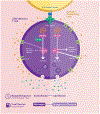PYGBacking on glycogen metabolism to fuel early memory T cell recall responses
- PMID: 35985300
- PMCID: PMC10052963
- DOI: 10.1016/j.molcel.2022.07.016
PYGBacking on glycogen metabolism to fuel early memory T cell recall responses
Abstract
Zhang et al. (2022) show that TCR signaling promotes the phosphorylation and activation of glycogen phosphorylase B (PYGB) in CD8+ memory T (Tmem) cells. PYGB-dependent glycogen mobilization provides a carbon source to support glycolysis and early Tmem cell recall responses.
Copyright © 2022 Elsevier Inc. All rights reserved.
Conflict of interest statement
Declaration of interests R.G.J. is a scientific advisor for Agios Pharmaceuticals and Servier Pharmaceuticals and is a member of the Scientific Advisory Board of Immunomet Therapeutics.
Figures

Comment on
-
TCR activation directly stimulates PYGB-dependent glycogenolysis to fuel the early recall response in CD8+ memory T cells.Mol Cell. 2022 Aug 18;82(16):3077-3088.e6. doi: 10.1016/j.molcel.2022.06.002. Epub 2022 Jun 22. Mol Cell. 2022. PMID: 35738262
Similar articles
-
TCR activation directly stimulates PYGB-dependent glycogenolysis to fuel the early recall response in CD8+ memory T cells.Mol Cell. 2022 Aug 18;82(16):3077-3088.e6. doi: 10.1016/j.molcel.2022.06.002. Epub 2022 Jun 22. Mol Cell. 2022. PMID: 35738262
-
Inhibition of brain-type glycogen phosphorylase ameliorates high glucose-induced cardiomyocyte apoptosis via Akt-HIF-1α activation.Biochem Cell Biol. 2020 Aug;98(4):458-465. doi: 10.1139/bcb-2019-0247. Epub 2020 Jan 6. Biochem Cell Biol. 2020. PMID: 31905009
-
Glycogen phosphorylase B promotes cell proliferation and migration through PI3K/AKT pathway in non-small cell lung cancer.Exp Lung Res. 2021 Apr;47(3):111-120. doi: 10.1080/01902148.2020.1864065. Epub 2020 Dec 18. Exp Lung Res. 2021. PMID: 33336613
-
New Roles for Glycogen in Tumor Progression.Trends Cancer. 2019 Jul;5(7):396-399. doi: 10.1016/j.trecan.2019.05.003. Epub 2019 May 31. Trends Cancer. 2019. PMID: 31311654 Review.
-
Mechanisms of blood glucose homeostasis.J Inherit Metab Dis. 1990;13(4):395-410. doi: 10.1007/BF01799497. J Inherit Metab Dis. 1990. PMID: 2122108 Review.
Cited by
-
Transient Structural Dynamics of Glycogen Phosphorylase from Nonequilibrium Hydrogen/Deuterium-Exchange Mass Spectrometry.J Am Chem Soc. 2024 Jan 10;146(1):298-307. doi: 10.1021/jacs.3c08934. Epub 2023 Dec 29. J Am Chem Soc. 2024. PMID: 38158228 Free PMC article.
-
Glucose-dependent glycosphingolipid biosynthesis fuels CD8+ T cell function and tumor control.bioRxiv [Preprint]. 2024 Oct 14:2024.10.10.617261. doi: 10.1101/2024.10.10.617261. bioRxiv. 2024. Update in: Cell Metab. 2025 Jul 30:S1550-4131(25)00333-X. doi: 10.1016/j.cmet.2025.07.006. PMID: 39464161 Free PMC article. Updated. Preprint.
References
-
- Bachem A, Makhlouf C, Binger KJ, de Souza DP, Tull D, Hochheiser K, Whitney PG, Fernandez-Ruiz D, Dahling S, Kastenmuller W, et al. (2019). Microbiota-Derived Short-Chain Fatty Acids Promote the Memory Potential of Antigen-Activated CD8(+) T Cells. Immunity 51, 285–297.e285. - PubMed
-
- Balmer ML, Ma EH, Bantug GR, Grahlert J, Pfister S, Glatter T, Jauch A, Dimeloe S, Slack E, Dehio P, et al. (2016). Memory CD8(+) T Cells Require Increased Concentrations of Acetate Induced by Stress for Optimal Function. Immunity 44, 1312–1324. - PubMed
-
- Gubser PM, Bantug GR, Razik L, Fischer M, Dimeloe S, Hoenger G, Durovic B, Jauch A, and Hess C (2013). Rapid effector function of memory CD8(+) T cells requires an immediate-early glycolytic switch. Nat Immunol 14, 1064–1072. - PubMed
-
- Ma EH, Verway MJ, Johnson RM, Roy DG, Steadman M, Hayes S, Williams KS, Sheldon RD, Samborska B, Kosinski PA, et al. (2019). Metabolic Profiling Using Stable Isotope Tracing Reveals Distinct Patterns of Glucose Utilization by Physiologically Activated CD8(+) T Cells. Immunity 51, 856–870.e855. - PubMed
-
- Ma R, Ji T, Zhang H, Dong W, Chen X, Xu P, Chen D, Liang X, Yin X, Liu Y, et al. (2018). A Pck1-directed glycogen metabolic program regulates formation and maintenance of memory CD8(+) T cells. Nat Cell Biol 20, 21–27. - PubMed
Publication types
MeSH terms
Substances
Grants and funding
LinkOut - more resources
Full Text Sources
Research Materials

